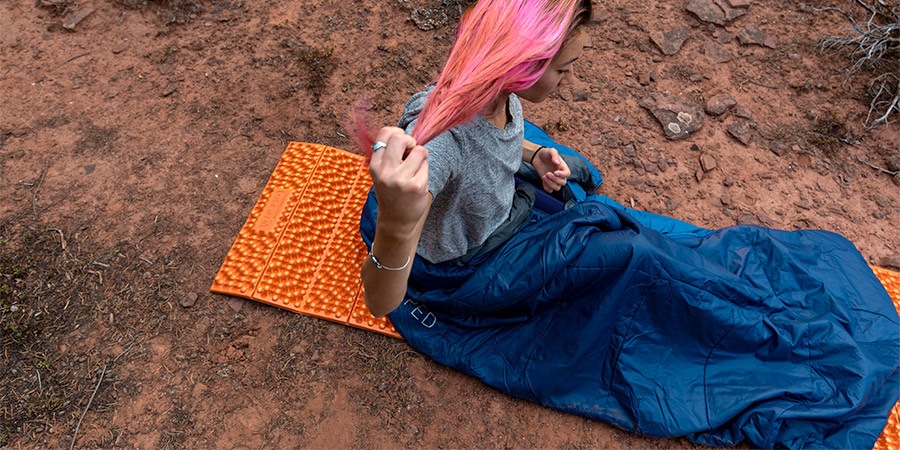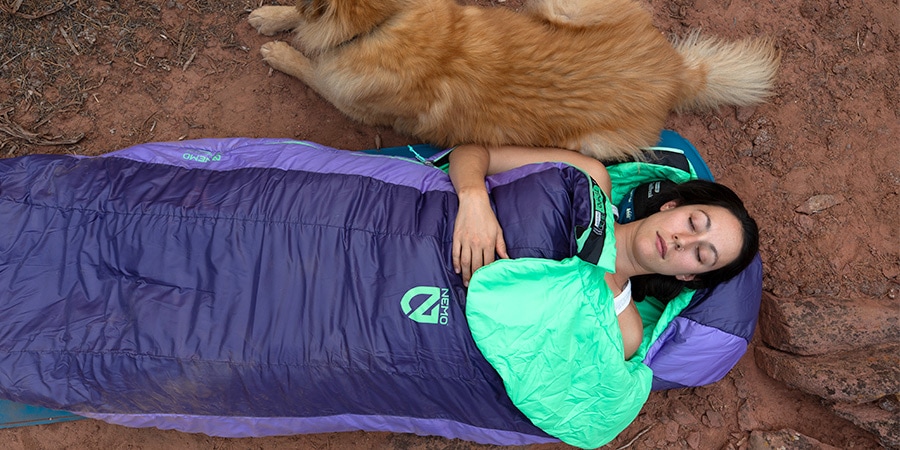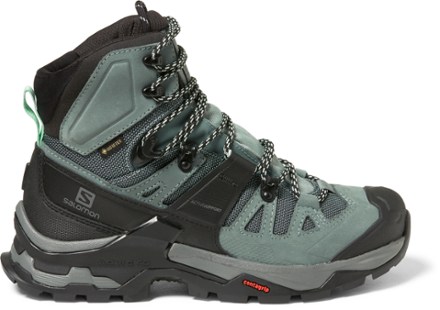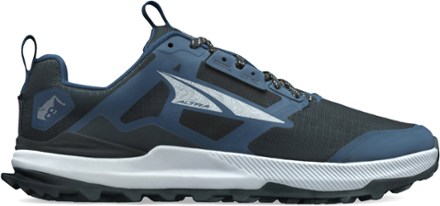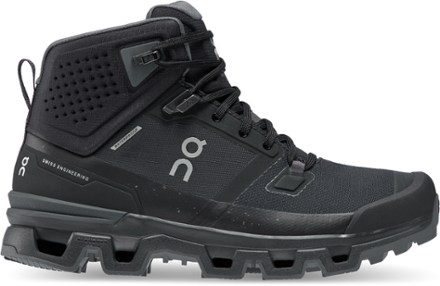One sleeping bag to rule them all—that's the Cosmic 20. This REI Co-op Editors' Choice Award winner stands atop the podium as the only budget bag on this list that uses down insulation, which gives it the best warmth-to-weight ratio in test. It also packs down to the size of a basketball, which means you can take it backpacking if you'd like.
The latest iteration of Kelty's three-season superstar uses 550-fill untreated duck down in lieu of the formerly used chemical-treated DriDown™. Paired with a 20-denier nylon taffeta shell fabric, the Cosmic 20 fairs OK in inclement weather. One tester reported that the sleeping bag shrugged off moisture on Virginia's Tuscarora Trail and dried quickly after being packed damp in the morning. "It was always fluffy and ready for bedtime," he reports. Note: The Cosmic 20 is entirely 550-fill-power down with a small percentage of polyester in the footbox, which helps the bag resist long-term compression.
Other features our testers loved? Chiefly, room for our feet. Kelty swapped in a trapezoidal footbox in the latest edition of the Cosmic 20, so our feet could fall naturally to the sides without feeling squished or cramped. Clever new baffling also helps the down loft on top of the footbox—and warm feet are happy feet. Another check in the comfort department: the 50-denier polyester-taffeta liner, which feels like silk bedsheets next to skin. And though the 62-inch shoulder dimensions are standard in this category, the 58-inch hip girth is roomier than many mummy bags. Also nice: There's a handy external stash pocket near the right shoulder. Buy here.
Editor's note: The men's version of the Cosmic 20 costs less than the women's. That's because the women's uses more down insulation to achieve a warmer temp rating. If you can handle the milder temp rating of the men's, you should go with that sleep sack, regardless of gender. Read more about
gendered sleeping bags
in our Buying Advice section.
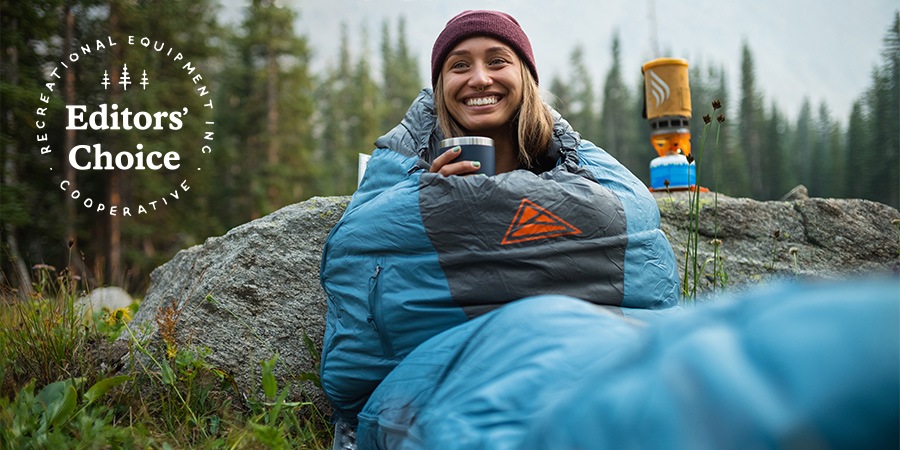
Bottom Line: High-quality down insulation and an entry-level price make the Kelty Cosmic 20 a solid choice for car campers and new backpackers alike.
Testing Stats:
- Nights out: 29
- Testing states: Colorado, Maryland, Virginia and West Virginia
- Best testing story: One member found refuge in the Cosmic 20. "The world was so hectic this summer that my favorite place became this cool ridge off the Appalachian Trail near Rocky Run," he says. "I'd find a flat spot to camp, crawl into my sleeping bag and stare at the stars to escape the madness."
One sleeping bag to rule them all—that's the Cosmic 20. This REI Co-op Editors' Choice Award winner stands atop the podium as the only budget bag on this list that uses down insulation, which gives it the best warmth-to-weight ratio in test. It also packs down to the size of a basketball, which means you can take it backpacking if you'd like.
The latest iteration of Kelty's three-season superstar uses 550-fill untreated duck down in lieu of the formerly used chemical-treated DriDown™. Paired with a 20-denier nylon taffeta shell fabric, the Cosmic 20 fairs OK in inclement weather. One tester reported that the sleeping bag shrugged off moisture on Virginia's Tuscarora Trail and dried quickly after being packed damp in the morning. "It was always fluffy and ready for bedtime," he reports. Note: The Cosmic 20 is entirely 550-fill-power down with a small percentage of polyester in the footbox, which helps the bag resist long-term compression.
Other features our testers loved? Chiefly, room for our feet. Kelty swapped in a trapezoidal footbox in the latest edition of the Cosmic 20, so our feet could fall naturally to the sides without feeling squished or cramped. Clever new baffling also helps the down loft on top of the footbox—and warm feet are happy feet. Another check in the comfort department: the 50-denier polyester-taffeta liner, which feels like silk bedsheets next to skin. And though the 62-inch shoulder dimensions are standard in this category, the 58-inch hip girth is roomier than many mummy bags. Also nice: There's a handy external stash pocket near the right shoulder. Buy here.
Editor's note: The men's version of the Cosmic 20 costs less than the women's. That's because the women's uses more down insulation to achieve a warmer temp rating. If you can handle the milder temp rating of the men's, you should go with that sleep sack, regardless of gender. Read more about
gendered sleeping bags
in our Buying Advice section.
Feel good about snoozing in this bag: Zippers aside, the Eco Trail Synthetic 20 is constructed almost entirely with recycled materials, beginning with the 50-denier polyester shell and ending with the 100 percent recycled synthetic insulation. Then, The North Face wraps up this eco-friendly package with a bow: The bag is treated with a durable water repellent free of perfluorinated chemicals (or PFCs) typically found in older-school finishes.
But Mother Nature's gain is not your loss—the Eco Trail Synthetic 20 is still warm. With an approximate temperature rating of 18°F, it should keep you toasty in mild, three-season conditions. "I slept without any shivers in mid-30 temps," reports one co-op member who tested the bag on a work trip to Alaska's Arctic National Wildlife Refuge. The same tester notes, however, that the bag didn't cut the windchill well; on gusty evenings, layer up.
The extended width in the knee area of the Eco Trail Synthetic 20 makes this mummy bag feel a little more comfortable, especially for larger sleepers (taller than 6 feet). "I still had an inch or two of wiggle room on each side," one says. Another cool design feature is the bag's J-shaped zipper, which lets you vent your core while keeping your feet covered. (The two-way zipper also means you can vent your feet while keeping your core warm, if you prefer.)
Packability is nothing to write home about, so make some extra space in your luggage: This bag stuffs down to the size of two volleyballs, making it best for car-camping and frontcountry pursuits. Buy here.
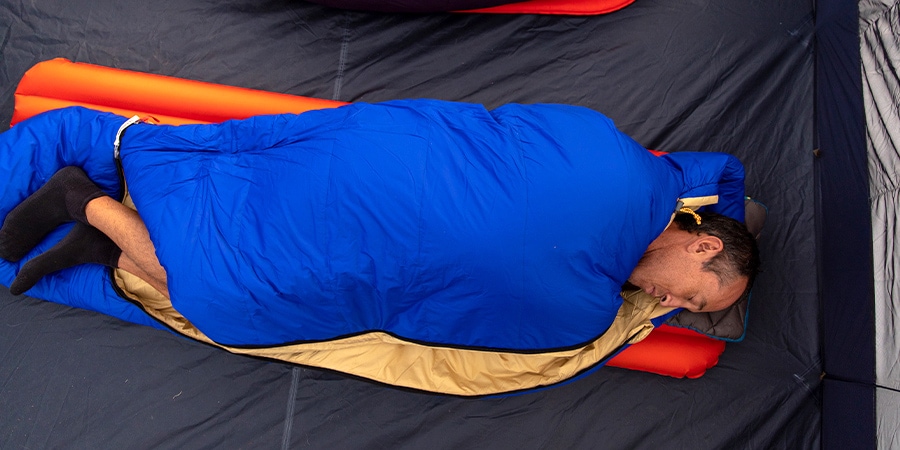
Bottom Line: The comfy North Trail Eco Trail Synthetic 20 has a lavish toe box and ample wiggle room, plus a bevy of planet-pleasing materials.
Testing Stats:
- Nights out: 32
- Best testing story: "Arctic National Wildlife Refuge may be famous for the herds of caribou, but what's really impressive are the mosquitoes," our tester says. "I literally had to drink them around Atigun Pass and could easily kill 20 with one slap. I came to think of my sleeping bag as my lone safe spot within the bug-free zone of my tent."
Feel good about snoozing in this bag: Zippers aside, the Eco Trail Synthetic 20 is constructed almost entirely with recycled materials, beginning with the 50-denier polyester shell and ending with the 100 percent recycled synthetic insulation. Then, The North Face wraps up this eco-friendly package with a bow: The bag is treated with a durable water repellent free of perfluorinated chemicals (or PFCs) typically found in older-school finishes.
But Mother Nature's gain is not your loss—the Eco Trail Synthetic 20 is still warm. With an approximate temperature rating of 18°F, it should keep you toasty in mild, three-season conditions. "I slept without any shivers in mid-30 temps," reports one co-op member who tested the bag on a work trip to Alaska's Arctic National Wildlife Refuge. The same tester notes, however, that the bag didn't cut the windchill well; on gusty evenings, layer up.
The extended width in the knee area of the Eco Trail Synthetic 20 makes this mummy bag feel a little more comfortable, especially for larger sleepers (taller than 6 feet). "I still had an inch or two of wiggle room on each side," one says. Another cool design feature is the bag's J-shaped zipper, which lets you vent your core while keeping your feet covered. (The two-way zipper also means you can vent your feet while keeping your core warm, if you prefer.)
Packability is nothing to write home about, so make some extra space in your luggage: This bag stuffs down to the size of two volleyballs, making it best for car-camping and frontcountry pursuits. Buy here.
It's the best kind of BOGO: Buy one sleeping bag, get a second free. The Exped MegaSleep 25/40 has one side that's rated to around 25°F and the other rated to around 40°F, so you can customize your warmth by choosing which side is on top. "It sounded gimmicky, but I actually loved having options," says one tester who tried out the MegaSleep 25/40 on the shores of New York's Lake Ontario. The same tester praised the convenience of being able to adjust the bag's warmth as temperatures dropped over the course of an evening.
Unlike other sleeping bags on this list, the MegaSleep 25/40 has a rectangular cut with a whopping 63 inches of shoulder width. The result: bed-like comfort. "I could actually fit my sleeping pad inside my bag with all the extra space," says one tester. All that comfort makes the bag too bulky for backpacking, however. It packs down to the size of a large watermelon.
This bag's versatility continues with a full-length zipper that wraps round the bottom, allowing campers to transform the bag into a quilt on warmer nights. Buy here.
Surveys say that as many as 75 percent of people prefer sleeping on their sides, but traditional mummy bags—which are warmer than their rectangular brethren—aren't ideal for this snoozing style. NEMO solves this conundrum by introducing its classic spoon-shape design to the Tempo 20, adding surplus inches to the shoulders and knees so side sleepers can rest easy. "I felt like I could pedal a bike," one tester says.
The Tempo 20 scored top marks for comfort for more than just the generous cut, though. The sleeping bag also has a blanket-like fold around the wide hood, so you're more likely to feel like you climbed into bed rather than a bag. It kept our testers warm down to the comfort rating, but there's a trade-off for all that synthetic insulation: It's well over 3 pounds and stuffs down to the size of two volleyballs. Only ambitious backpackers would want to tote this thing to faraway campsites (which we did, in the spirit of quality testing, but did note that the bag took up one-third of our 50-liter pack's storage).
Other nice features in the Tempo 20: an integrated pillow pocket (stash your puffy inside), a zippered stash pocket and compatible zippers. The men's and women's versions of this bag (which are really just warm sleeper's and cold sleeper's versions, read more below) can zip together for evening snuggle sessions. Buy here.
The most affordable bag in our test, the REI Co-op Trailbreak 20 is suited well for chilly nights with a lower limit of 18°F and 5°F (for the men's and women's, respectively) and a narrow mummy cut. (The smaller the space, the easier it is for your body to warm up the bag. Read more below.) It also has a three-panel hood with double drawcords to create a snug fit and boost warmth, plus a plush draft tube, or insulation that runs along the zipper to help prevent cold from sneaking in—both features more typical of backpacking and mountaineering bags. We didn't notice any cold spots, even on evenings below 35°F. "I actually had to use the Trailbreak 20 as a quilt one evening because I was too warm," our Washington tester said after a night that dipped into the 40s.
Synthetic insulation and polyester shell that's treated with a durable water repellent make this sleeping bag a decidedly good choice for damp conditions. "Condensation was dripping inside the tent and onto the sleeping bag, but I stayed dry and cozy," our tester said after a rainy night in Washington's Colville National Forest.
Bulk is a consideration, though: "If you piled six Nalgene bottles together, this bag would still be larger," noted one tester. Our crew also struggled with a snagging zipper, reporting that users must pull the bag taut in order for the zipper to properly slide. But still, at this price point, the Trailbreak 20 is an awesome deal. Buy here.
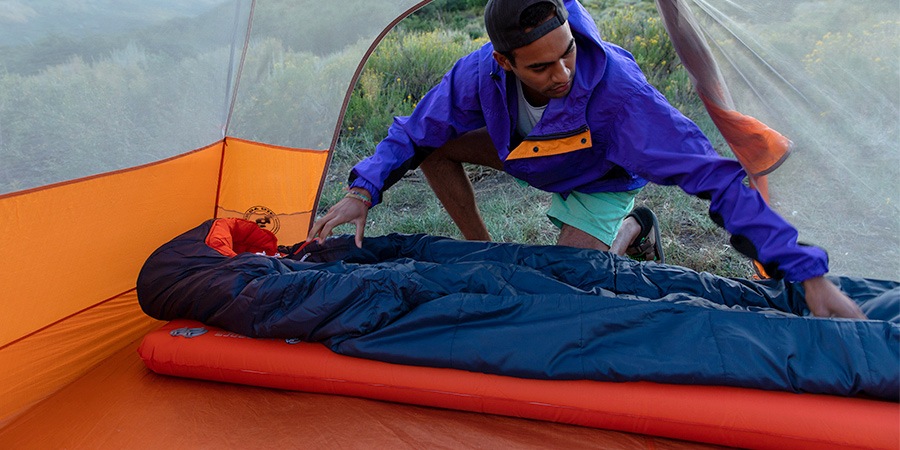
Bottom Line: The REI Co-op Trailbreak 20 is a screaming deal for entry-level backpackers or car campers who don't mind the confines of a mummy bag.
Testing Stats:
- Nights out: 11
- Testing states: Colorado, Washington
- Best testing story: "Snuggling up in the Trailbreak 20 outside the tent as the sun set over the high alpine and watching the alpenglow sweep across the Cascades has to be the absolute best part of my entire year," one tester says.
The most affordable bag in our test, the REI Co-op Trailbreak 20 is suited well for chilly nights with a lower limit of 18°F and 5°F (for the men's and women's, respectively) and a narrow mummy cut. (The smaller the space, the easier it is for your body to warm up the bag. Read more below.) It also has a three-panel hood with double drawcords to create a snug fit and boost warmth, plus a plush draft tube, or insulation that runs along the zipper to help prevent cold from sneaking in—both features more typical of backpacking and mountaineering bags. We didn't notice any cold spots, even on evenings below 35°F. "I actually had to use the Trailbreak 20 as a quilt one evening because I was too warm," our Washington tester said after a night that dipped into the 40s.
Synthetic insulation and polyester shell that's treated with a durable water repellent make this sleeping bag a decidedly good choice for damp conditions. "Condensation was dripping inside the tent and onto the sleeping bag, but I stayed dry and cozy," our tester said after a rainy night in Washington's Colville National Forest.
Bulk is a consideration, though: "If you piled six Nalgene bottles together, this bag would still be larger," noted one tester. Our crew also struggled with a snagging zipper, reporting that users must pull the bag taut in order for the zipper to properly slide. But still, at this price point, the Trailbreak 20 is an awesome deal. Buy here.
Shop All Sleeping Bags
Buying Advice
A quality sleeping bag can make or break your next camping adventure, but it may feel daunting if you don't understand what to look for before making your choice. Here are a few factors to consider when snagging yourself a sleeping bag, regardless of its price tag.
Weight and Size
When it comes to car camping, you can simply pick the warmest, roomiest sleeping bag you like because you won't be shouldering it. For a rundown on all the things to consider, read How to Choose Sleeping Bags for Camping.
For backpacking, however, you'll want the warmest, roomiest sleeping bag that fits inside your pack and doesn't weigh you down. You can of course tote however much weight you'd like backpacking, but in this guide, the Kelty Cosmic 20 and REI Co-op Trailbreak 20 are the best for it. They're lighter and a bit more compact than the others here.
Note that some sleeping bags have a men's or unisex version and a women's version. Though this is how the brand has distinguished them, a more helpful delineation is to think of them as "warm sleeper's" and "cold sleeper's."
Warm sleeper's bags (or men's or unisex) have bigger dimensions and more forgiving temperature ratings. Cold sleeper's bags (or women's) have smaller dimensions and warmer temperature ratings thanks to added insulation. That often makes the cold sleeper's version of the bag heavier and bulkier, despite its smaller dimensions.
Type of Insulation
Sleeping bags are filled with either down insulation or synthetic insulation. In general, down insulation (made from goose or duck plumage) is lighter and more packable, offering the best warmth to weight. Down isn't inherently water-resistant, but today, most is treated to make it hydrophobic. Down insulation is also very durable and will likely hold up to years of packing and unpacking it into a stuff sack. Trade-off: It tends to cost more than synthetic.
The Kelty Cosmic 20 is the only bag on our list that uses down insulation.
Note: If you opt for a down sleeping bag, be sure to check out the ethical practices of the company making your sleeping bag. These days, most outdoor brands have standards that protect the welfare of the animals, but it's a good idea to be informed.
On the flipside, synthetic insulation (like polyester) retains more warmth when wet, making it a popular choice with folks who live in moist climates. It also dries faster than down and is less likely to aggravate allergies. As an added bonus, it is almost always cheaper than down, too. Synthetic insulation is bulkier than down, however, and often comes with a weight penalty.
Shape
In this guide, you'll see two shapes of sleeping bags: mummy and rectangular.
A mummy is wider in the shoulders before tapering at the knees and footbox. This eliminates extra space inside the sleeping bag, making it easier to create and maintain warmth. It also cuts down on materials and weight, which makes this style popular in the backpacking and ultralight communities.
But there's still some variation there. The Kelty Cosmic 20 and REI Co-op Trailbreak 20 have the narrowest dimensions in our test. The North Face Eco Trail Synthetic 20 and NEMO Tempo 20, on the other hand, are cut wider, which makes them better options for side sleepers and folks who want more space to curl up or spread out inside their bags.
A rectangular sleeping bag looks just like it sounds: a large rectangle. The bag does not taper like a mummy bag does and instead maintains its shape to give campers maximum wiggle room. Often, rectangular bags can be fully unzipped and used like a comforter, too. However, this shape does mean there is more dead space in the bag, making it tougher to stay warm.
The Exped MegaSleep 24/40 is the only rectangular bag on our list.
Temperature Rating
We could pen a thesis on how temperature ratings are determined, but for you, dear reader, all you need to know is that the number in the name of the sleeping bag is pretty close to what its lower limit is. So our most basic advice is to purchase a sleeping bag with a number that's 10°F to 15°F lower than what you expect to encounter on your coldest trips. (Err on the side of going too warm because you can always unzip your bag or kick a leg out.) For example, if you do most of your camping in the mountains where temperature drop into the 30s at night, go for a bag that has 20 in the name.
In general, summer-season camping calls for bags rated to 30°F or higher. Three-season camping (which includes shoulder seasons) usually requires bags with ratings closer to 20°F. You won't find anything that much warmer for less than $200 on the market (the warmer the bag, the more it costs, generally).
Of course, choosing a temperature rating is an exercise in knowing yourself, too. If you're a person who is always cold, take that into consideration.
Temperature Ratings, Explained
Remember that thesis? It would go something like this.
Being able to compare one brand's 20°F bag against another's used to be a problem because outdoor brands tested them differently. Decades of work to standardize those ratings thankfully means nearly all brands play by the same rules now, though those rules are complicated.
An "ISO" or "EN" temperature rating indicates the test standard used. Either requires rigorous, standardized testing and the two standards are roughly comparable. So, as long as a bag has one of those acronyms, you can compare their temperature ratings. All but one bag in this guide use the ISO standard. Read Understanding Sleeping Bag Temperature Ratings to learn more.
Note that, while these test standards can be applied to most backpacking bags, certain sleeping bags are not covered by the standards. Sleeping bags without hoods like the Exped MegaSleep 25/40 are assigned temperature ratings by varying tests used by the brand.
Bags are assigned two temperature ratings: limit and comfort ratings. Lower-limit rating is the lowest temperature at which the bag will keep a warm sleeper comfortable and is generally the temperature assigned to men's or unisex bags. Comfort rating is the lowest temperature at which the bag will keep the average cold sleeper comfortable and is generally the temperature assigned to women-specific bags. If a temperature rating omits the term "comfort" or "limit," then it's likely a brand's estimate, not an ISO or EN test result.
Cold sleeper's (women's) bags that use the warmer "comfort rating" as their standard will inevitably be heavier than the equivalent warm sleeper's (men's) bags. It simply requires more of a given insulation to achieve more warmth.
A temperature rating is not a guarantee of warmth. Standardized ratings are super important because you can more reliably compare bags from different brands. But metabolisms vary greatly from person to person, as do variables like the pad you pair your bag with, humidity, wind, type of shelter, ground conditions, clothing and personal preferences.
Methodology
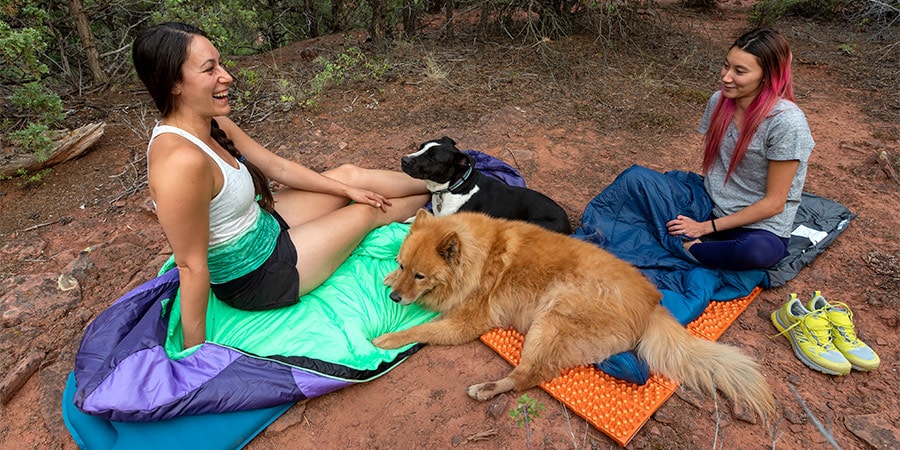
In the spring and summer of 2020, we asked 13 co-op members from around the country to sacrifice their shut-eye for you and spend some nights under the stars in their local wilds. We sent around a dozen of the best budget sleeping bags sold at REI, and they got sleeping on frigid granite surfaces in Washington's Cascades, through relentless windstorms in Colorado's high country, amid Virginia squalls that leaked into tents and, yes, even above the Arctic Circle.
After seven months of testing, they evaluated each sleeping bag on its warmth, weight, packability and durability. We then averaged their scores and distilled their feedback. The five sleeping bags in this gear guide are their favorites, the highest-scoring bags of the bunch.
Photography by William M. Rochfort, Jr. Will is a freelance writer and photographer based in Carbondale, Colorado. His hobbies include backpacking, bikepacking and skiing with his wife and daughter, but he is mainly known for his rare ability to double-fist milkshakes prior to meals. REI member since 1998.



